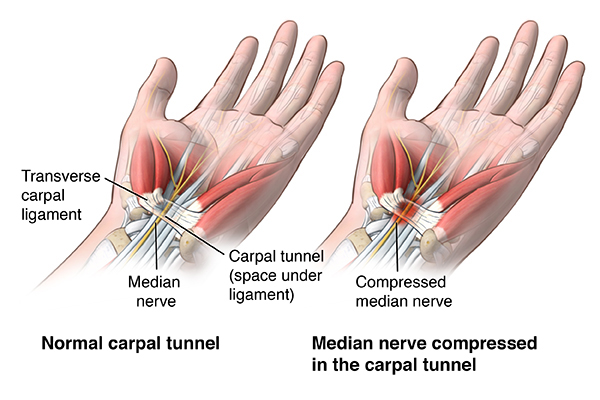Carpal Tunnel Release
Carpal tunnel release is a surgical procedure used to treat carpal tunnel syndrome, a condition caused by the compression of the median nerve as it passes through the carpal tunnel in the wrist. This procedure aims to relieve symptoms like pain, numbness, and weakness in the hand and fingers.
Why Carpal Tunnel Release is Done
- To alleviate persistent symptoms that don't respond to non-surgical treatments (e.g., splints, medications, or physical therapy).
- To prevent permanent nerve damage or loss of hand function in severe cases.
Types of Carpal Tunnel Release Surgery
- Open Surgery:
- A small incision is made in the palm to access and cut the transverse carpal ligament, relieving pressure on the median nerve.
- Endoscopic Surgery:
- A minimally invasive approach using one or two small incisions and a camera-guided instrument to release the ligament.
Procedure Steps
- Preparation:
- The hand and wrist are cleaned and sterilized.
- Local or general anesthesia is administered.
- Surgery:
- Open Surgery: A 1-2 inch incision is made in the palm.
- Endoscopic Surgery: Small incisions are made, and an endoscope is inserted.
- The surgeon cuts the transverse carpal ligament to relieve pressure on the median nerve.
- Closing:
- Incisions are closed with sutures, and a bandage is applied.
Recovery Timeline
- Immediate:
- Numbness and tingling often improve right after surgery.
- Pain at the incision site is common for the first few days.
- 1-2 Weeks:
- Sutures are removed during a follow-up visit.
- Light activities can be resumed.
- 4-6 Weeks:
- Gradual return to full use of the hand for non-strenuous activities.
- 3 Months and Beyond:
- Full recovery, including strength and sensation improvement, may take several months.
Post-Operative Care
- Wound Care:
- Keep the incision clean and dry.
- Follow your doctor's instructions for dressing changes.
- Hand Exercises:
- Physical therapy may be recommended to restore mobility and strength.
- Avoid:
- Heavy lifting or repetitive wrist movements during recovery.
Risks of Surgery
- Infection at the incision site.
- Stiffness or swelling in the hand or wrist.
- Injury to the median nerve or surrounding structures.
- Persistent or recurring symptoms (rare).
- Scarring or tenderness at the incision site.
Alternatives to Surgery
- Wrist splints (especially at night).
- Nonsteroidal anti-inflammatory drugs (NSAIDs).
- Corticosteroid injections.
- Activity modification or ergonomic adjustments.



